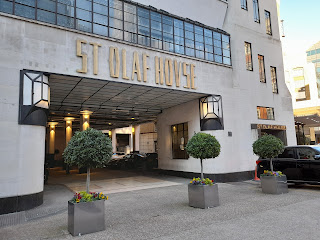 It's good to be in Norway again on Norse and Viking business and today I had a free day in Oslo. I'm almost ashamed to say that despite coming here regularly for many decades and even living here a long time ago, I had never been up to Ekeberg. Until, that is, when, on a previous trip in a brief Covid lull last December (on different Norse and Viking business), our group was taken up there for dinner one night, and a very fine dinner it was too. Seeing what a fabulous view there is from up there of the city, particularly the newer parts of the city in Bjørvika, I decided I really needed to go back up that hill on my next visit. So there I was today in Ekebergparken, on a slightly chilly but still beautifully sunny spring day, ready for both friluftsliv and cultural experiences. And, wow, there are certainly a lot of those!
It's good to be in Norway again on Norse and Viking business and today I had a free day in Oslo. I'm almost ashamed to say that despite coming here regularly for many decades and even living here a long time ago, I had never been up to Ekeberg. Until, that is, when, on a previous trip in a brief Covid lull last December (on different Norse and Viking business), our group was taken up there for dinner one night, and a very fine dinner it was too. Seeing what a fabulous view there is from up there of the city, particularly the newer parts of the city in Bjørvika, I decided I really needed to go back up that hill on my next visit. So there I was today in Ekebergparken, on a slightly chilly but still beautifully sunny spring day, ready for both friluftsliv and cultural experiences. And, wow, there are certainly a lot of those!
24 April 2022
On Oak Hill I
19 March 2022
Tooley Street Delight
On academic business in London the other day, I chanced upon Tooley Street, just near London Bridge Underground station. Now, I've known about Tooley Street for a long time, but never actually visited it, which was clearly remiss of me, as you will understand below.
Tooley Street takes its name from St Óláfr of Norway, or rather from a church dedicated to that saint, as explained by Bruce Dickins in a classic article in Saga-Book in 1940 (pp. 67-68). As Dickins shows, there are quite a few churches dedicated to the saint in London, but this one is special, since its site is very close to one of Óláfr's youthful exploits, as recorded in the poem Víkingarvísur by the king's Icelandic poet Sigvatr Þórðarson, and edited by yours truly some years ago.
The poem recounts, in a numbered list of battles, the future king's youthful adventures in England and across the European continent. Stanza 6 is as follows:Rétts, at sókn in sétta,
(snarr þengill bauð Englum
at) þars Ôleifr sótti
(Yggs) Lundúna bryggjur.
Sverð bitu vǫlsk, en vǫrðu
víkingar þar díki;
átti sumt í sléttu
Súðvirki lið búðir.It is correct that the sixth battle [took place] where Óláfr attacked the wharves of London; the valiant prince offered the English {the strife of Yggr <= Óðinn>} [BATTLE]. Frankish swords bit, and vikings defended the ditch there; some of the troop had huts in level Southwark.
At the end, he returns to Norway to become king and eventually martyr, Scandinavia's first royal saint, and rex perpetuus Norvegiae (Norway's forever king).
An inscription on the corner of the building gives a brief history of the site and mentions Óláfr's military activities in the vicinity. However the exact history of all this is difficult to determine. Back in 2013 I wrote: 'Although Óláfr appears to have fought for the English King Aðalráðr (Æthelred) after the death of Sveinn tjúguskegg ‘Fork-beard’ in 1014, Snorri’s claim that Óláfr’s earlier battles were fought in support of him ... is probably erroneous ... His earlier English campaigns seem rather to have been fought alongside Þorkell inn hávi and the Danes ..., and it appears that Óláfr ‘like his friend Þorkell, changed sides and became a supporter of Æthelred’ (A. Campbell 1971, 12). The skaldic stanzas do not in themselves clarify who Óláfr’s allies and opponents were, nor exactly where and when he fought; even when they are considered in conjunction with the English and Norse prose sources much remains uncertain ...' And it goes without saying that the idea that Óláfr’s exploits are commemorated in the nursery rhyme 'London Bridge is falling down' is most likely fanciful.
The other corner of the building depicts the royal saint in all his regal majesty, rather than as a young attacker (or possibly defender - the stanza is a bit ambiguous) of a muddy ditch. It is this subsequent saintly and regal figure, rather than the youthful warrior on his gap year abroad, that is commemorated in this very fine building. I'm glad to have discovered it for myself and can recommend it as a must visit for anyone who loves both Art Deco and royal Viking saints....










